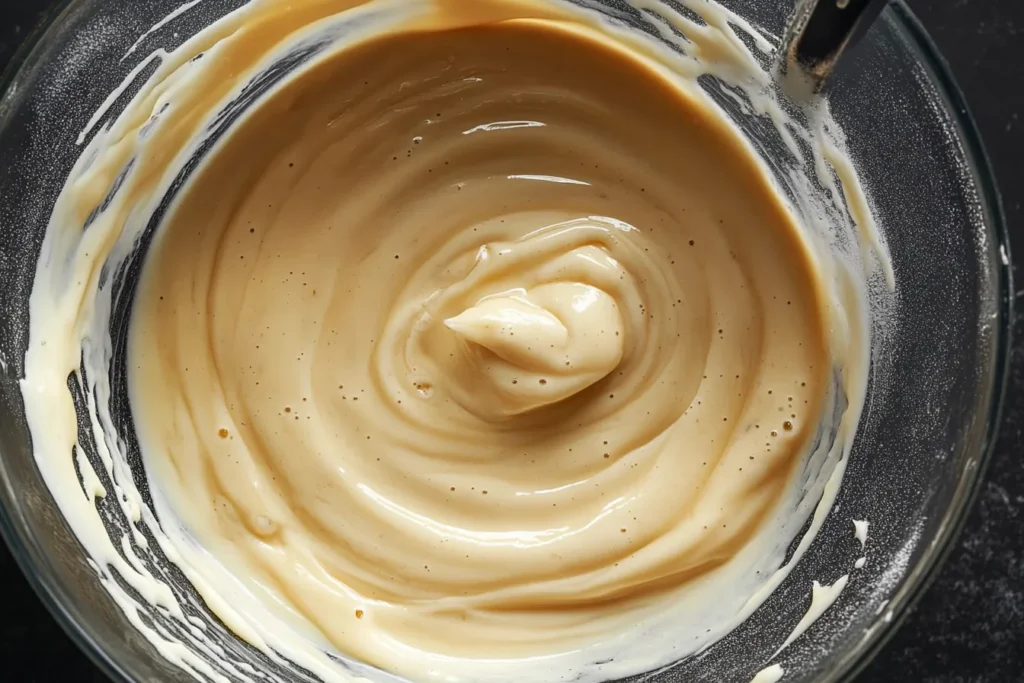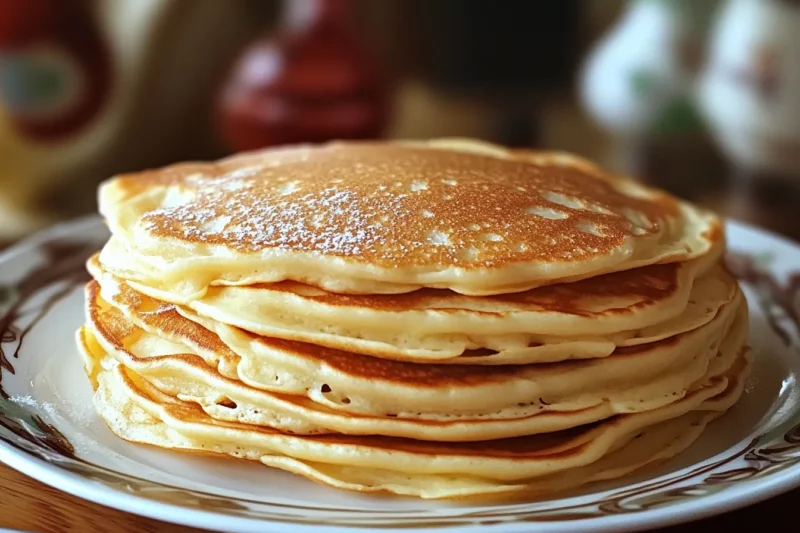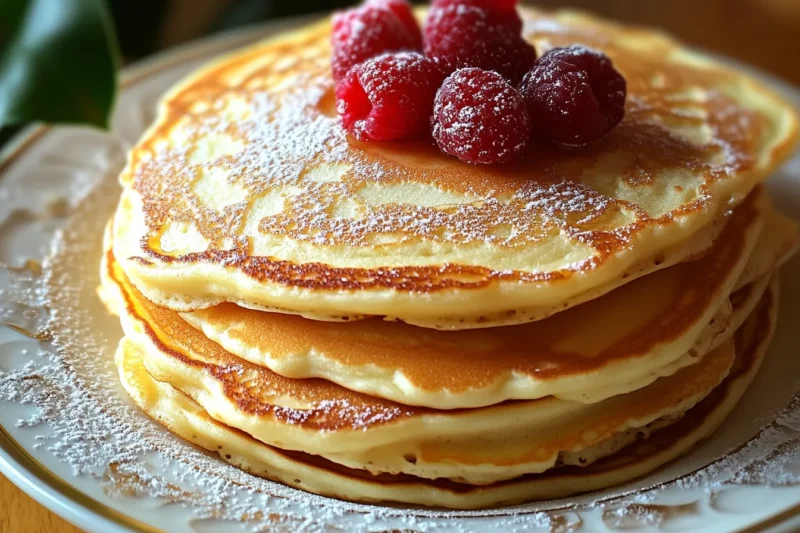Key Takeaways
- Milk adds a richer, more complex flavor to pancake batter compared to water.
- Milk’s higher protein and fat content can make pancakes fluffier and better textured.
- Getting the right temperature and mixing techniques is key for fluffy pancakes at home.
- Trying different mi-lk options, like plant-based ones, can meet various dietary needs.
- Using the right tools, like a griddle or skillet, can help you make professional-quality pancakes.
The Science Behind Perfect Pancake Batter
Making the perfect pancake batter is an art that needs a deep understanding of pancake science. It involves knowing the liquid-to-dry ratio, the role of proteins, and the fat content. Each part is crucial for the right texture and flavor.
Understanding Liquid-to-Dry Ratio
The balance between liquid and dry ingredients is key in pancake batter. The right liquid-to-dry ratio gives the batter the perfect consistency. This ensures even cooking and light, fluffy pancakes. Changing this ratio can greatly affect the batter’s texture, from runny to dense.
How Proteins Affect Texture
Proteins in eggs and milk are vital for pancake texture. When heated, they form a network that traps air. This results in soft, tender pancakes. Managing the protein in pancakes well can make a big difference in texture.
The Role of Fat Content
Fat in pancake batter adds to the mouthfeel and flavor. Fats like butter or oil make the pancakes richer and more indulgent. They also help with even browning and a crisp exterior. Finding the right balance of fat is key to improving your pancakes.
Understanding these key elements can help you make perfect pancake batter every time. With a bit of experimentation and attention to detail, you’ll create pancakes that impress anyone.
Does Milk Instead of Water Make Pancakes Better
Choosing between milk and water in pancake batter can change the taste and texture. Let’s see how this simple choice can make your pancakes better.
Mi-lk adds a richer flavor to pancakes. Its natural sweetness and creaminess make pancakes taste more indulgent. This is great if you want your pancakes to taste like they’re from a diner.
| Characteristic | Milk-Based Pancakes | Water-Based Pancakes |
|---|---|---|
| Flavor | Richer, creamier taste | Simpler, more muted flavor |
| Texture | Softer, more tender crumb | Denser, chewier texture |
| Browning | Deeper, more golden color | Lighter, less pronounced browning |
Milk-based pancakes are also softer and fluffier. The proteins and fat in mi-lk make the crumb tender. This makes pancakes feel more indulgent.
Milk also helps pancakes brown better. This makes them look more appealing and appetizing. It adds to the charm of your homemade breakfast.
While milk has clear benefits, taste preferences vary. Some like the simple taste of water-based pancakes. The choice between mi-lk and water depends on what you prefer.
The Benefits of Using Milk in Pancake Recipes
Choosing between mi-lk and water in pancake recipes can change the taste and texture. Using milk in your batter can make your pancakes taste like they’re from a restaurant. It’s a simple way to make your breakfast special.
Enhanced Flavor Profile
Milk gives pancakes a creamy flavor that water can’t match. It adds a sweet taste and dairy notes that make pancakes more enjoyable. Whether you’re making classic buttermi-lk pancakes or trying new flavors, mi-lk makes them taste better.
Improved Texture and Fluffiness
Milk’s proteins and fats help pancakes be soft and fluffy. They make the pancakes melt in your mouth. The extra moisture keeps pancakes light and airy, making them a hit with everyone.
Better Browning Results
Milk’s sugars caramelize well, making pancakes golden brown. This not only looks good but also adds a crispy edge. The soft inside and crispy outside make pancakes perfect.
Want to make your pancakes better? Try using mi-lk instead of water. Your taste buds and guests will love it!
Common Mistakes When Making Milk-Based Pancakes
Making milk-based pancakes is a fun cooking adventure. But, it comes with some common mistakes. Knowing these pancake mistakes and mi-lk pancake tips will help you make great pancakes every time.
One big mistake is overworking the batter. It might seem right to mix a lot, but it makes pancakes tough. Just mix the ingredients gently until they’re just combined.
Another mistake is not greasing the pan well enough. If you don’t grease it well, pancakes stick and don’t cook evenly. Make sure to grease the pan well with butter, oil, or non-stick spray.
- Ensure the cooking surface is heated to the optimal temperature before adding the batter.
- Use a generous amount of butter, oil, or non-stick cooking spray to prevent sticking and promote even browning.
Finally, don’t fill the pan too much. Too many pancakes at once make them steam instead of sear. This changes their texture and look.
| Common Milk Pancake Mistakes | Milk Pancake Tips |
|---|---|
| Overworking the batter | Gently fold the ingredients together |
| Insufficient greasing of the cooking surface | Use generous amounts of butter, oil, or non-stick cooking spray |
| Overcrowding the cooking surface | Cook pancakes in batches to ensure proper searing and texture |
By avoiding these pancake mistakes and using the right mi-lk pancake tips, you’ll make delicious pancakes. They’ll taste great and impress everyone.
How to Achieve Diner-Style Fluffy Pancakes at Home
Want to make diner-style pancakes at home? It’s easier than you think. Just a few tricks can make your pancakes as fluffy as those from your favorite diner.
Temperature Control Tips
Getting the right temperature is key. Heat your griddle or pan to 350°F to 375°F. This ensures your pancakes cook evenly and stay light and fluffy (Does milk instead of water make pancakes better).
Mixing Techniques
Mixing the batter gently is important. Overmixing makes pancakes tough. Mix just until the ingredients are combined, leaving a few lumps. This keeps the batter light and airy, just like diner pancakes.
Resting Time Importance
Don’t skip the resting time! Let your batter rest for at least 15 minutes. This lets the gluten relax and the leavening agents work their magic. Your pancakes will be light, tender, and irresistibly fluffy.
With these simple tips, you can make diner pancakes at home. Your breakfast will be a hit with family and friends. These fluffy pancakes will impress anyone.
Preventing Burnt Chocolate Chips in Your Pancakes
Nothing ruins a batch of chocolate chip pancakes like burnt chocolate chips. They should add a sweet surprise, not a bitter taste. If you’ve wondered why your chocolate chips burn in pancakes, we have the answers.
To avoid burnt chocolate chips, focus on timing and batter prep. Here are some tips to keep your chocolate chips perfect:
- Wait until the last moment to add chocolate chips. Mixing them too early can cause them to melt and burn.
- Choose mini chocolate chips. They melt more evenly, reducing burn risk.
- Use chocolate chunks instead of chips. They’re less likely to burn.
- Lower the cooking temperature. High heat can burn chocolate quickly. Use a medium setting for better results.
| Technique | Description | Impact on Chocolate Chips |
|---|---|---|
| Late Chocolate Chip Addition | Fold in chips just before cooking | Prevents premature melting and burning |
| Mini Chocolate Chips | Use smaller-sized chocolate chips | Melts more evenly throughout pancake |
| Chocolate Chunks | Use larger chocolate pieces instead of chips | Less prone to burning during cooking |
| Lower Cooking Temperature | Adjust griddle or pan to medium heat | Allows chocolate to melt gradually without burning |
Try these tips for chocolate chip pancakes that are always perfect. Enjoy the rich, melty chocolate in every bite, without the burnt taste.
Alternative Milk Options for Different Dietary Needs
Looking for tasty, dairy-free pancakes? The world of plant-based milk alternatives is full of choices. Whether you’re avoiding lactose, following a vegan diet, or just want to try something new, these options can change your pancake game (Does milk instead of water make pancakes better).
Plant-Based Milk Substitutes
The dairy-free world has many milk alternatives, each with its own taste and texture. You can choose from creamy almond milk to nutty cashew milk. These options are great for those who don’t drink dairy milk.
- Almond milk: It has a light, creamy texture and a subtle nutty flavor. This makes it perfect for delicate dairy-free pancakes.
- Soy milk: It’s rich in protein and can make your pancakes feel like they have dairy milk’s body and structure.
- Oat milk: It’s naturally sweet and a bit thicker. This adds a special flavor to your dairy-free pancakes.
- Coconut milk: It brings a tropical, rich taste. This can make your plant-based milk alternatives pancakes extra special.
Impact on Final Results
Choosing the right milk alternative can change how your pancakes taste, feel, and look. Trying different plant-based milk alternatives can help you get the perfect pancake. You might want them fluffy or rich, depending on your taste.
Exploring these dairy-free options opens up a world of flavors. You can please many dietary needs while enjoying delicious pancakes that fit your unique tastes (Does milk instead of water make pancakes better).
Professional Tips for Restaurant-Quality Pancakes
If you want to make pancakes as good as those in restaurants, you’re in the right place. Chefs and home cooks share secrets to make your pancakes fluffy and golden. Let’s dive into the insider tips and tricks for restaurant pancakes that are perfect for brunch (Does milk instead of water make pancakes better).
First, focus on your batter consistency. Finding the right liquid-to-dry ratio is key for creating amazing pancakes. Try different milk-to-flour mixes to get tender, fluffy pancakes.
- Don’t overmix the batter, as it can make pancakes tough.
- Let the batter rest for 10-15 minutes to relax the gluten, making pancakes more tender.
Temperature control is also crucial for restaurant-quality pancakes. Keep the cooking temperature steady, whether using a griddle or skillet. This ensures even browning and prevents burning or undercooking.
“The secret to amazing pancakes is all in the technique. Temperature and timing are everything when it comes to achieving that perfect golden-brown exterior and light, fluffy interior.”
Lastly, don’t shy away from trying different toppings and mix-ins. Add fresh fruit, chocolate chips, nuts, or even bacon or cheese. The options are endless for restaurant pancakes.
By using these professional tips, you’ll soon be making restaurant-quality pancakes that everyone will love. What is the secret of amazing pancakes? It’s all about the details and mastering pancake-making.
Essential Equipment and Tools for Perfect Pancakes
To make great pancakes, you need the right tools and equipment. We’ll look at the best items for making pancakes like a pro at home. This includes everything from choosing between a griddle and a pan to keeping an eye on the temperature (Does milk instead of water make pancakes better).
Griddle vs. Pan Comparison
Choosing between a griddle and a pan can affect your pancakes. Griddles are bigger, letting you cook more pancakes at once. They also keep a steady pancake temperature, making your pancakes golden and even.
Pans, however, are more flexible. They’re good for pancakes and other breakfast foods, or even dinner.
Temperature Monitoring Tools
- Digital Thermometer: A digital thermometer is key for keeping the pancake temperature just right. It ensures your pancakes are always perfect.
- Pancake tools like Infrared Thermometer: An infrared thermometer lets you check the griddle or pan’s temperature easily. This helps you get the pancake temperature spot on.
- Oven Thermometer: An oven thermometer near your cooking area helps you keep an eye on the temperature. It lets you adjust as needed for the best pancake temperature.
Whether you like using a griddle or a pan, having the right pancake tools and ways to check the temperature is key. It’s all about mastering the art of making perfect pancakes at home.
| Feature | Griddle | Pan |
|---|---|---|
| Surface Area | Larger | Smaller |
| Consistent Temperature | Better | Varies more |
| Versatility | Limited | Higher |
| Ease of Use | Simpler | More Skill Required |
Conclusion
In this article, we’ve looked at the benefits of using milk in pancake recipes. Milk adds flavor, texture, and fluffiness to pancakes. It’s all about the science behind the batter.
Creating great pancakes at home is more than just picking the right ingredients. It’s also about the techniques you use. Pay attention to temperature, mixing, and letting the batter rest. These small steps can make a big difference.
Try different milks to meet your dietary needs. Add chocolate chips or fruit for a special touch. The journey to perfect pancakes is full of tasty discoveries.
Embrace the benefits of milk in pancakes and follow these tips. With patience and attention to detail, you’ll make pancakes that everyone will love. Enjoy every step and every bite!
FAQ
Why do my chocolate chips burn in pancakes?
Chocolate chips can burn in pancakes because they have a lot of sugar and melt easily. To stop this, fold the chocolate chips into the batter gently before cooking. Also, don’t over-mix the batter. Using chocolate chunks or chips made for baking can help too.
What is the secret of amazing pancakes?
Making amazing pancakes involves a few secrets. First, get the liquid-to-dry ingredient ratio right. Then, mix the batter well to add air. Lastly, cook the pancakes at the right temperature. Letting the batter rest before cooking also helps.
Why are diner pancakes so fluffy?
Diner pancakes are fluffy because of a few reasons. They use more liquid than dry ingredients. They’re mixed carefully to add air. And, they’re cooked at the perfect temperature to rise and stay fluffy.
What is the best chocolate chip pancake recipe?
The top chocolate chip pancake recipe uses a classic buttermilk batter. Then, it gently folds in quality chocolate chips before cooking. The buttermilk makes the pancakes tender and fluffy, while the chocolate chips add a tasty flavor.



